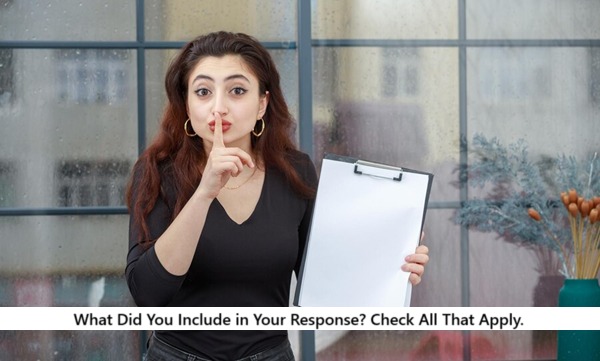In the digital age, where everyone is searching for concise, helpful, and accurate information, crafting a thoughtful response is both an art and a science. Whether you’re replying to a customer query, writing an email, or publishing content, what you include in your response can make all the difference. This blog post explores the essential elements to consider when crafting your response and how including them can elevate its quality and relevance. After all, the ultimate goal is to meet the needs of the reader or audience—right?
Why Is It Important to Include the Right Information?
Before diving into the specifics, let’s highlight the purpose of this discussion: A well-crafted response ensures clarity, builds trust, and fulfills the reader’s intent. Every detail you include (or omit) impacts how your audience perceives and interacts with your message. Whether it’s answering a question or addressing a concern, the right response fosters connection and satisfaction.
Now, let’s break it down step by step.
Key Elements to Include in Your Response
1. Answer the Question Directly
The first step in any effective response is to address the primary query. Imagine asking someone, “What time is the meeting?” and receiving a vague answer like, “It’s later today.” Frustrating, isn’t it?
Instead, ensure your response includes:
- A direct answer to the main question.
- Any supporting details that clarify your point.
Example:
Question: What time is the meeting?
Response: The meeting is at 3 PM EST. It will be held in the main conference room on the second floor.
2. Provide Relevant Context
While brevity is valuable, sometimes a little context goes a long way. Context helps your audience understand the “why” behind your answer, making it more meaningful and trustworthy.
Example:
Without Context: The product isn’t available right now.
With Context: The product isn’t available right now due to high demand, but we expect it to be back in stock next week. You can sign up for notifications to know when it’s available again.
3. Offer Actionable Steps
Your response should guide the reader on what to do next. This could include links, instructions, or recommendations. Think of it as helping them move forward with clarity.
Example:
If someone asks about improving their website’s SEO, you might say:
Response: Start by optimizing your content with relevant keywords. Use tools like Google Keyword Planner to research trends. Additionally, ensure your website loads quickly and has a mobile-friendly design.
4. Be Honest and Transparent
No one appreciates a sugar-coated or misleading answer. If you don’t have the answer or there’s a limitation, say so—but offer alternatives where possible.
Example:
Honest Approach: I don’t have that information right now, but I’ll follow up with you by tomorrow.
5. Maintain a Conversational Tone
People prefer responses that feel human. Avoid jargon or overly formal language unless your audience expects it. A friendly tone fosters trust and engagement.
Example:
Too Formal: We regret to inform you that the package has been delayed due to unforeseen logistical challenges.
Conversational: Hi! Your package is delayed due to some unexpected shipping issues. We’re working on it and will have it delivered ASAP. Thanks for your patience!
6. Anticipate Follow-Up Questions
A great response doesn’t just answer the current question; it also preempts related queries. Think about what the reader might ask next and address it upfront.
Example:
Basic Response: Your application has been approved.
Improved Response: Your application has been approved. You’ll receive a confirmation email shortly with the next steps. If you don’t see it within 24 hours, feel free to reach out to us.
7. Include Visual Elements Where Appropriate
Sometimes, a picture, chart, or bullet list can convey information more effectively than words alone. Use visuals to enhance clarity and break up large chunks of text.
Example:
Instead of writing out a list of steps, format them like this:
- Log into your account.
- Navigate to the “Settings” page.
- Click “Change Password” and follow the prompts.
8. Double-Check for Accuracy
A misleading or incorrect response can do more harm than good. Take a moment to verify any data, links, or claims before hitting send.
Example:
If referencing a statistic, include the source:
Response: According to a recent study by Statista, 60% of users prefer mobile-friendly websites.
9. Keep It Concise
While it’s important to be thorough, avoid overloading your response with unnecessary information. Stick to the point while providing enough detail to satisfy the reader’s curiosity.
Example:
Instead of:
The event is scheduled to take place on January 25th at the Grand Hotel Ballroom, which is located at 123 Main Street. The start time is 7 PM, and attendees are advised to arrive at least 15 minutes early to secure parking and check in.
Use:
The event is on January 25th at 7 PM in the Grand Hotel Ballroom (123 Main Street). Arrive 15 minutes early for parking and check-in.
10. End with a Call to Action (CTA)
Encourage your audience to take the next step. Whether it’s clicking a link, signing up, or contacting support, make it easy for them to follow through.
Example:
Looking to learn more? Visit our help center or reach out to us directly at support@example.com.
Conclusion
Crafting an effective response is about more than just answering questions—it’s about creating a meaningful interaction that leaves your audience feeling informed, valued, and understood. By including direct answers, context, actionable steps, and a friendly tone, you can ensure your responses hit the mark every time.
The next time you’re crafting a response, ask yourself: What did I include? Check all that apply. If you’ve addressed the key elements outlined above, you’re well on your way to delivering a response that not only meets but exceeds expectations. After all, a great response is one that solves problems and builds trust—and isn’t that what we all want?
